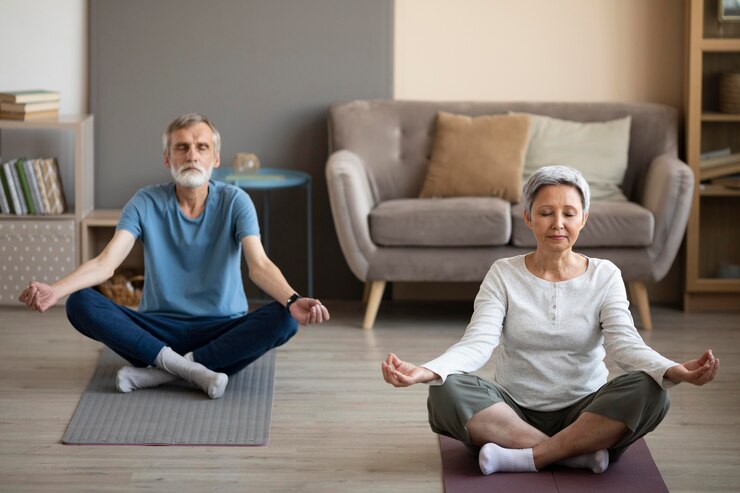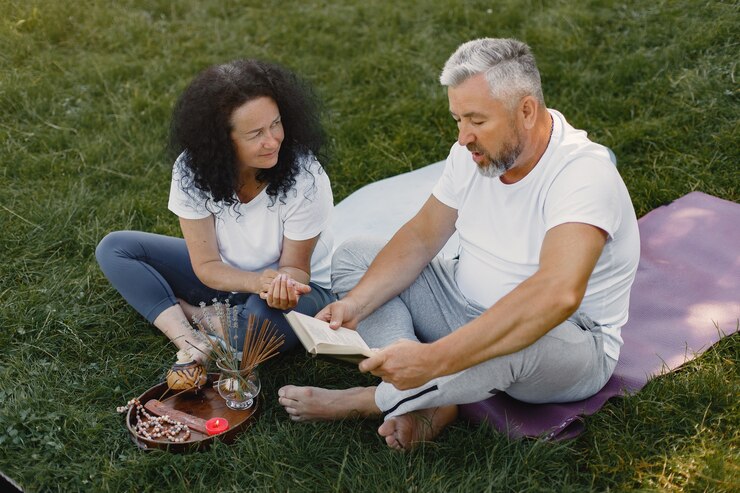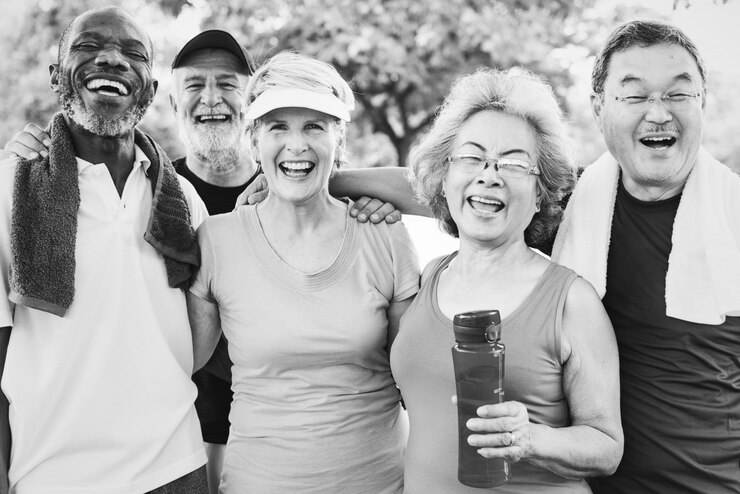Mindfulness and Meditation: Techniques for Seniors

In today’s fast-paced world, mindfulness and meditation have become vital tools for managing stress, improving mental clarity, and promoting overall well-being. Incorporating these practices into daily routines can provide a range of physical, emotional, and cognitive benefits for seniors. Whether you’re looking to reduce anxiety, improve sleep, or cultivate a deeper sense of inner peace, mindfulness and meditation can be powerful allies in navigating the challenges of aging.
Maintaining a healthy mind becomes just as important as caring for the body. Mindfulness and meditation offer seniors an accessible and effective way to stay mentally sharp, emotionally balanced, and physically relaxed. These practices are gentle, require no special equipment, and can be adapted to suit individual needs and abilities.
In this post, we’ll explore the benefits of mindfulness and meditation for seniors, practical techniques for getting started, and how incorporating these practices into daily life can enhance one’s overall quality of life.
The Benefits of Mindfulness and Meditation for Seniors

Mindfulness and meditation are more than just buzzwords—they offer scientifically proven benefits that can significantly improve the lives of seniors. Both practices focus on calming the mind, being present in the moment, and creating a deeper awareness of your thoughts, emotions, and body.
1. Reducing Stress and Anxiety
Aging often brings new challenges, whether adjusting to retirement, coping with health issues, or dealing with loss. Mindfulness and meditation provide powerful tools for managing these stressors by helping seniors develop a sense of calm and acceptance.
Research has shown that regular mindfulness practice reduces the production of cortisol, the stress hormone, which can have a calming effect on the body and mind. Meditation techniques such as deep breathing or focusing on a calming thought can help quiet the mind, reduce feelings of anxiety, and promote emotional resilience.
2. Improving Sleep Quality
Sleep problems are common as we age, with many seniors experiencing insomnia or disrupted sleep. Mindfulness and meditation can help seniors improve their sleep patterns by calming the mind and relaxing the body before bedtime. Practices like guided meditations, body scans, and deep breathing can signal to the body that it’s time to unwind, making it easier to fall asleep and stay asleep throughout the night.
Better sleep leads to improved cognitive function, mood, and overall energy levels, making mindfulness and meditation a natural solution for seniors who want to wake up feeling refreshed.
3. Enhancing Cognitive Health
One of the most exciting benefits of mindfulness and meditation is their impact on cognitive health. Studies have shown that regular meditation can increase gray matter in areas of the brain associated with memory, learning, and emotional regulation. This is especially important for seniors as it can help maintain mental sharpness and slow cognitive decline.
Mindfulness practices that focus on attention and awareness have been linked to improvements in focus, decision-making, and memory, making them valuable tools for seniors who want to stay mentally agile.
4. Managing Chronic Pain and Physical Discomfort
Many seniors live with chronic or physical discomfort due to arthritis, back pain, or other age-related conditions. Mindfulness practices teach individuals to observe their pain without becoming overwhelmed, allowing them to manage discomfort more easily.
Meditation techniques such as body scans or mindful breathing can help seniors shift their focus away from pain, reducing its intensity and promoting relaxation. This doesn’t mean the pain disappears, but rather, seniors can learn to experience it in a less distressing way, making daily life more manageable.
5. Fostering Emotional Well-Being
Mindfulness and meditation are excellent tools for fostering emotional balance and well-being. By practicing mindfulness, seniors can become more aware of their emotions without judgment, allowing them to process feelings healthily. This can be especially helpful for seniors dealing with feelings of loneliness, grief, or depression.
Meditation encourages self-compassion, helping seniors develop a kinder, more understanding relationship with themselves. As a result, they may experience increased positive emotions, greater emotional resilience, and an overall sense of contentment.
Mindfulness and Meditation Techniques for Seniors

The beauty of mindfulness and meditation is that they are adaptable to individual needs and can be practiced in various settings—whether sitting at home, taking a walk, or even lying in bed. Here are some easy-to-follow techniques that seniors can incorporate into their daily lives.
1. Mindful Breathing
Mindful breathing is one of the simplest and most effective techniques for reducing stress and centering the mind. This practice involves focusing on the breath moving in and out of the body, helping you stay present and grounded in the moment.
To practice mindful breathing, find a quiet place to sit or lie down. Close your eyes, if comfortable, and take slow, deep breaths. Pay attention to the sensation of the air as it enters your nose, fills your lungs, and leaves your body. If your mind wanders, gently bring your focus back to the breath. Even a few minutes of mindful breathing can have a calming effect on the mind and body.
2. Body Scan Meditation
The body scan is a mindfulness technique that promotes relaxation by guiding your attention through different body parts. This practice helps seniors become more aware of areas where they may be holding tension or discomfort and encourages deep relaxation.
To practice a body scan, find a comfortable position, sitting or lying down. Start by focusing on your toes, noticing any sensations, and gradually work your way up the body, paying attention to each part—from your feet to your legs, hips, torso, arms, and finally, your head. As you move through the body, release tension and allow each part to relax.
3. Guided Meditation
Guided meditation is a wonderful option for seniors who are new to meditation or prefer to be guided through the process. These meditations are typically led by an instructor, either in person or through recordings, who guides participants through various mindfulness exercises.
Numerous guided meditations are available online, through apps, or even on YouTube. These can range from simple breathing exercises to more complex visualizations that promote relaxation and positive thinking. Guided meditations can vary in length, so it’s easy to find one that fits your schedule and preferences.
4. Walking Meditation
Walking meditation combines mindfulness with gentle movement for seniors who enjoy being active. This practice involves walking slowly and mindfully, paying close attention to each step, feeling your feet touching the ground, and the rhythm of your breath.
Walking meditation can be done indoors or outdoors, making it a versatile option for those who prefer to stay active while meditating. It’s an excellent way to stay present, enjoy the surroundings, and integrate mindfulness into daily activities.
5. Loving-Kindness Meditation
Loving-kindness meditation (also known as “metta” meditation) focuses on cultivating compassion and positive emotions toward oneself and others. This practice is particularly beneficial for seniors experiencing feelings of loneliness or isolation.
To practice loving-kindness meditation, sit comfortably and begin by focusing on yourself. Repeat phrases such as “May I be happy, may I be healthy, may I be safe.” Then, gradually extend these feelings of compassion to others—starting with loved ones, friends, and eventually all living beings. This practice fosters a sense of connection and emotional warmth, which can significantly improve emotional well-being.
Tips for Incorporating Mindfulness and Meditation into Daily Life

While mindfulness and meditation offer numerous benefits, the key is consistency. Here are some tips to help seniors incorporate these practices into their daily routines:
1. Start Small and Build Gradually
If you’re new to mindfulness and meditation, starting small is important. Begin with just a few minutes each day, and gradually increase the duration as you become more comfortable with the practice. Even five minutes of mindful breathing or meditation can affect how you feel.
2. Create a Routine
Setting aside a specific time for mindfulness or meditation each day can help make it a regular part of your routine. Whether it’s first thing in the morning or just before bed, find a time that works for you and stick to it. Consistency is key to reaping the long-term benefits of mindfulness and meditation.
3. Find a Comfortable Space
Create a peaceful, comfortable space to practice mindfulness or meditation without distractions. This could be a quiet corner of your home, a spot in the garden, or even a favorite chair. Having a designated space can help you get into the right mindset for relaxation.
4. Be Patient with Yourself
Mindfulness and meditation are skills that take time to develop, so it’s important to be patient with yourself. If your mind wanders during meditation, don’t get discouraged—simply acknowledge the thought and gently return to your practice. Over time, you’ll find it easier to stay focused and calm.
5. Use Technology to Support Your Practice
Many apps and online resources are available to help seniors get started with mindfulness and meditation. Apps such as Calm, Headspace, and Insight Timer offer guided meditations, mindfulness exercises, and helpful tips for consistent practice.
Conclusion

Mindfulness and meditation offer seniors a valuable opportunity to nurture body and mind. These gentle practices promote relaxation, reduce stress, enhance cognitive function, and foster emotional well-being—all while being accessible and easy to integrate into daily life. By incorporating techniques such as mindful breathing, body scan meditation, and loving-kindness meditation, seniors can enjoy these practices’ many benefits.
Staying mentally and emotionally healthy is just as important as physical health, and mindfulness and meditation offer a powerful way to achieve balance, peace, and joy in your senior years. With regular practice, these simple techniques can lead to a deeper sense of well-being, helping you navigate the challenges of aging with grace and mindfulness.





